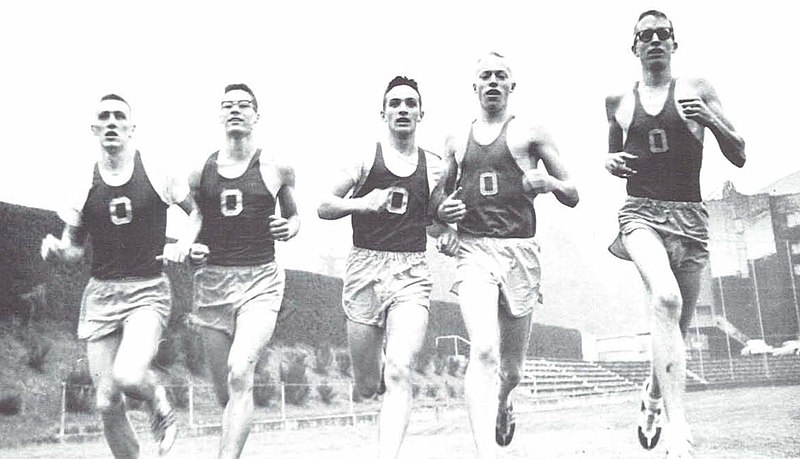Unleashing Greatness: Phil Knight’s Journey of Visionary Leadership

Trailblazing Leadership: Unveiling Phil Knight’s Unforgettable Legacy
In the annals of leadership and entrepreneurship, there are few figures as iconic and influential as Phil Knight. With a career spanning over four decades, Knight revolutionized the world of business and sports, leaving an indelible mark on the global landscape. As the co-founder and former CEO of Nike, Knight’s leadership prowess and relentless pursuit of greatness propelled the company from humble beginnings to a multi-billion-dollar powerhouse.
Knight’s journey is one of audacity, vision, and unwavering determination. From his modest upbringing in Portland, Oregon, to the creation of one of the most recognizable brands in the world, his story is a testament to the power of leadership and the transformative effect it can have on individuals, organizations, and society as a whole.
Nike’s genesis was not without its challenges. In the early years, Knight faced numerous obstacles, including financial constraints, fierce competition, and skepticism from industry giants. Yet, it was Knight’s visionary leadership that would steer Nike towards unparalleled success. With a burning desire to disrupt the status quo and redefine the athletic footwear industry, he set out to create a company that would embody the spirit of innovation, performance, and empowerment.
At the heart of Knight’s leadership philosophy was the ability to articulate a compelling vision. He possessed an uncanny ability to inspire and motivate others, effectively communicating his passion for sports, quality, and pushing boundaries. Through his vision, Nike became more than a mere brand; it became a symbol of aspiration, athleticism, and achievement. Knight understood that a shared purpose was vital in galvanizing a team, fostering a culture of excellence, and propelling the organization forward.
However, Knight’s leadership prowess extended beyond vision alone. He was a master of assembling and nurturing winning teams. Recognizing that success was a collective effort, he surrounded himself with individuals who complemented his own skills and brought diverse perspectives to the table. Through meticulous hiring and a commitment to cultivating a culture of collaboration and trust, Knight fostered an environment where innovation thrived and exceptional results were achieved.
Central to Knight’s leadership style was his willingness to take calculated risks. He embraced the notion that with great risk comes great reward. Knight understood that progress and breakthroughs are born from pushing boundaries, embracing uncertainty, and challenging conventional wisdom. Throughout Nike’s history, Knight made bold decisions that catapulted the company into new territories, including groundbreaking marketing campaigns, endorsement deals with athletes, and strategic partnerships. These calculated risks, though not without their share of setbacks, propelled Nike to unprecedented heights and solidified its status as a global leader.
Yet, Knight’s journey was not without its moments of adversity and failure. The ability to bounce back, learn from mistakes, and persevere in the face of challenges became defining characteristics of his leadership. Knight understood that setbacks were not an indication of defeat but rather stepping stones on the path to success. His unwavering resilience and unyielding persistence served as beacons of inspiration, not only within Nike but also for aspiring leaders worldwide.
Beyond his achievements in business, Knight’s legacy extends to his philanthropic endeavors. He recognized the importance of giving back and making a positive impact on society. Through his charitable initiatives, including contributions to education, healthcare, and environmental conservation, Knight demonstrated that leadership goes beyond financial success. It encompasses a responsibility to use one’s influence for the betterment of others.
As we delve into the leadership lessons and stories of Phil Knight, we embark on a journey of discovery and inspiration. Through his extraordinary experiences, we uncover valuable insights that can transform our own approach to leadership. Knight’s ability to forge a powerful vision, build exceptional teams, embrace risk, overcome adversity, and leave a lasting legacy serves as a guiding light for leaders across industries and generations.
Join us as we delve into the depths of Phil Knight’s leadership legacy, exploring the triumphs, challenges, and enduring lessons that define his remarkable career. In this comprehensive exploration of Knight’s leadership journey, we aim to uncover the principles and wisdom that can empower leaders to unleash their full potential and shape the future of their organizations.
Background and Early Years:
Phil Knight’s upbringing and formative experiences
Phil Knight was born on February 24, 1938, in Portland, Oregon, into a middle-class family. Growing up, Knight developed a passion for sports, particularly running. Athletics became an integral part of his life, instilling in him the values of discipline, perseverance, and teamwork.
Knight’s academic journey led him to Stanford University, where he earned a Bachelor’s degree in journalism and a Master’s degree in business administration. It was during his time at Stanford that he wrote a pivotal paper outlining his vision for a sports shoe company that would import high-quality footwear from Japan, thus revolutionizing the athletic shoe industry. This paper laid the groundwork for the birth of Nike.
The inception of Nike and the challenges faced during its early years
In 1964, fresh out of Stanford, Knight embarked on a journey to bring his vision to life. He formed a partnership with his former track coach, Bill Bowerman, and together they founded Blue Ribbon Sports (BRS). Initially operating as a distributor for Japanese athletic shoe brand Onitsuka Tiger (now ASICS), BRS faced considerable challenges in its early years.
Financial constraints posed a significant hurdle for Knight and Bowerman, forcing them to bootstrap their operations. They sold shoes out of the trunk of Knight’s car, traveling to track meets and athletic events to connect with potential customers. This hands-on approach allowed Knight to understand the needs and preferences of athletes firsthand, providing invaluable insights for future product development.
However, their relationship with Onitsuka Tiger became strained, leading Knight to take a bold step in 1971. He decided to part ways with Onitsuka Tiger and rebrand their own line of shoes under the name Nike, inspired by the Greek goddess of victory. This pivotal decision marked the birth of a global phenomenon.
Key traits and qualities exhibited by Knight during this phase
Knight’s leadership during Nike’s formative years showcased several key traits and qualities that would define his approach to business and shape the company’s culture. Here are some notable characteristics:
-
Visionary mindset: Knight possessed a visionary mindset from the outset. His early paper outlining the concept of importing high-quality Japanese athletic shoes foreshadowed the disruptive path Nike would take. He envisioned a future where Nike would empower athletes to unleash their full potential and transcend the limitations of traditional footwear.
-
Entrepreneurial spirit: Knight embodied the spirit of entrepreneurship. He took risks, embraced uncertainty, and remained undeterred in the face of challenges. His relentless drive to innovate and disrupt the market propelled Nike forward, establishing it as a trailblazer in the industry.
-
Passion for excellence: Knight’s passion for excellence permeated every aspect of Nike’s operations. He had an unwavering commitment to delivering top-quality products that met the rigorous demands of athletes. This uncompromising pursuit of excellence became a cornerstone of Nike’s brand identity and its commitment to athletic performance.
-
Relationship-building skills: Knight excelled in building relationships and forging strategic partnerships. From his partnership with Bill Bowerman to securing endorsement deals with world-class athletes, Knight understood the power of collaboration and the influence of strong alliances in driving business success.
Knight’s background, early experiences, and the challenges he encountered in Nike’s formative years laid a solid foundation for the leadership lessons he would later impart. These experiences shaped his mindset, fostered resilience, and ignited his passion to transform Nike into a global powerhouse.
Visionary Leadership:
Articulating a compelling vision
One of the defining aspects of Phil Knight’s leadership was his ability to articulate a compelling vision that resonated with employees, customers, and stakeholders. Knight possessed a remarkable clarity of purpose and effectively communicated his vision for Nike as more than just a shoe company. He saw Nike as a catalyst for inspiring athletes worldwide, empowering them to push beyond their limits and achieve greatness. This vision created a sense of purpose and direction, rallying the entire organization around a shared goal.
Knight’s vision went beyond mere words; it manifested in Nike’s products, marketing campaigns, and company culture. Every shoe, apparel line, and brand initiative was a tangible representation of his vision to innovate, inspire, and enhance athletic performance. By aligning the organization around this compelling vision, Knight created a sense of purpose that ignited passion and fostered a collective drive for excellence.
Inspiring a shared purpose
Knight understood that to achieve extraordinary results, he needed to inspire a shared purpose among his employees. He cultivated a culture that celebrated individual talents, fostered collaboration, and encouraged everyone to contribute to the company’s mission. By embracing diversity of thought and empowering his team members, Knight created an environment where innovation thrived.
Furthermore, Knight’s leadership style was characterized by accessibility and approachability. He believed in open communication, actively listening to ideas, and encouraging constructive dialogue. Knight understood that great ideas could come from anyone within the organization, and he made a concerted effort to create an inclusive culture that embraced diverse perspectives.
By inspiring a shared purpose, Knight nurtured a sense of ownership and commitment within his team. Employees felt a deep connection to the company’s mission, driving them to go above and beyond in their efforts. This shared purpose not only propelled Nike’s growth but also cultivated a strong sense of loyalty among employees and fostered a vibrant, passionate work culture.
Fostering innovation
Knight’s leadership was synonymous with innovation. He recognized that to stay ahead in a highly competitive industry, Nike had to constantly push the boundaries of technology, design, and performance. Knight fostered a culture that encouraged risk-taking, experimentation, and embracing failure as a catalyst for growth.
Knight was not afraid to challenge conventions and disrupt traditional approaches. Nike’s iconic “Just Do It” campaign, for instance, epitomized this mindset. It redefined how a sports brand connected with consumers, emphasizing the values of determination, perseverance, and personal achievement. The campaign became a cultural phenomenon, capturing the essence of Nike’s brand and resonating with people worldwide.
By fostering innovation, Knight encouraged his team to think creatively, explore new possibilities, and anticipate the evolving needs of athletes and consumers. Nike’s relentless focus on research and development, technological advancements, and design breakthroughs propelled the company to the forefront of the industry. Knight’s visionary leadership provided the framework for continuous innovation, ensuring Nike’s relevance and market leadership.
In summary, Phil Knight’s visionary leadership laid the foundation for Nike’s enduring success. Through the power of a compelling vision, he united the organization, fueled passion, and inspired greatness. By fostering a shared purpose and embracing innovation, Knight created an environment that propelled Nike’s growth and cemented its position as a global leader in the athletic footwear and apparel industry.
Building a Winning Team:
The role of team building in Knight’s success
Phil Knight understood that building a winning team was crucial to achieving sustainable success. He recognized that the collective efforts of talented individuals who shared a common vision could propel Nike to new heights. Knight’s ability to assemble and nurture a high-performing team became instrumental in the company’s growth and innovation.
Building a winning team started with Knight’s emphasis on hiring individuals who not only possessed the necessary skills and expertise but also aligned with Nike’s values and culture. He sought out passionate individuals who shared his dedication to excellence, innovation, and the pursuit of greatness. This deliberate approach to hiring ensured that each team member brought a unique perspective and contributed to the overall strength of the organization.
Hiring and retaining top talent
Knight’s leadership was characterized by his keen eye for talent. He had an innate ability to identify individuals who had the potential to make a significant impact. Whether it was hiring skilled designers, innovative marketers, or visionary leaders, Knight understood the importance of surrounding himself with the best in the industry.
To attract and retain top talent, Knight fostered an environment that offered opportunities for growth, personal development, and career advancement. He provided resources for training and skill enhancement, empowering employees to continually expand their capabilities. Additionally, Knight encouraged a culture of mentorship and learning, where experienced team members mentored and guided new recruits, fostering a sense of camaraderie and knowledge sharing.
Knight also recognized the importance of diversity within the team. He understood that a diverse workforce brought varied perspectives and enhanced creativity, leading to better decision-making and innovation. By actively promoting diversity and inclusion, Knight ensured that Nike’s talent pool was reflective of the diverse communities it served.
Nurturing a culture of collaboration, trust, and diversity: Knight fostered a culture that emphasized collaboration, trust, and diversity, enabling teams to thrive and unleash their full potential. He recognized that great achievements were seldom the result of individual efforts alone, but rather the collective contributions of a cohesive team.
Knight promoted an open and inclusive work environment where everyone’s ideas and opinions were valued. He encouraged healthy debates, challenging the status quo, and fostering an atmosphere of constructive criticism. This collaborative approach not only led to better decision-making but also empowered employees to take ownership and contribute their unique perspectives.
Trust was another essential element of Knight’s team-building strategy. He believed in delegating responsibility and giving team members the autonomy to make decisions. By trusting his employees, Knight created an environment that empowered individuals to take risks, innovate, and take ownership of their work. This trust-based culture fostered a sense of accountability and instilled a shared commitment to achieving organizational goals.
Furthermore, Knight recognized that diversity was a driving force behind innovation and creative problem-solving. He championed diversity and inclusion initiatives, creating a space where individuals from different backgrounds, cultures, and experiences could thrive. By embracing diversity, Knight ensured that Nike had a workforce that could understand and cater to the diverse needs of its global customer base.
Phil Knight’s emphasis on building a winning team through strategic hiring, talent development, and nurturing a culture of collaboration, trust, and diversity played a pivotal role in Nike’s success. By surrounding himself with exceptional individuals who shared his vision, Knight created a dynamic and innovative workforce. The collaborative and inclusive environment fostered by Knight empowered employees to reach their full potential, driving Nike’s growth and reinforcing its position as a leader in the industry.
Taking Calculated Risks:
Embracing risk-taking as a core leadership principle
Phil Knight’s leadership was characterized by his willingness to embrace calculated risks. He recognized that playing it safe and sticking to the status quo would hinder Nike’s growth and limit its potential for innovation. Instead, Knight encouraged a culture of calculated risk-taking, understanding that great rewards often came from stepping outside of comfort zones and challenging conventional wisdom.
Knight believed that to stay ahead of the competition, Nike needed to be at the forefront of industry trends and consumer demands. This required taking risks, whether it was launching groundbreaking marketing campaigns, introducing new product lines, or entering new markets. He understood that calculated risks were essential for driving growth and maintaining a competitive edge.
Analyzing Knight’s bold decisions and their impact on Nike’s growth
Throughout Nike’s history, Phil Knight made bold decisions that shaped the trajectory of the company. One such decision was signing endorsement deals with high-profile athletes, including Michael Jordan, which revolutionized the concept of sports endorsements and elevated Nike’s brand to unprecedented heights. This strategic move not only bolstered Nike’s market share but also solidified its position as a dominant force in the sports industry.
Another significant risk Knight took was venturing into international markets, particularly in Asia. Recognizing the potential for growth beyond the United States, Knight expanded Nike’s reach globally. Despite facing cultural and logistical challenges, this move allowed Nike to tap into new consumer markets and establish a strong global presence.
Additionally, Knight pushed the boundaries of traditional marketing through innovative campaigns. The iconic “Bo Knows” campaign, featuring athlete Bo Jackson, and the “Find Your Greatness” campaign during the Olympics showcased Nike’s bold and unconventional approach. These campaigns not only captured the attention of consumers but also reinforced Nike’s position as a brand that celebrated individuality and inspired greatness.
Knight’s calculated risks propelled Nike’s growth, expanding its market share, increasing brand visibility, and driving financial success. By fearlessly challenging the norm and taking strategic leaps, Knight demonstrated that calculated risk-taking is a fundamental aspect of leadership that can lead to remarkable achievements.
Balancing risk and reward: Lessons on calculated risk-taking
Knight’s approach to risk-taking offers valuable lessons for leaders navigating complex and competitive landscapes. Here are key lessons on balancing risk and reward:
-
Strategic analysis: Knight understood the importance of conducting thorough research and analysis before taking risks. This involved assessing market trends, understanding consumer needs, and evaluating potential returns. Strategic analysis helped Knight identify opportunities and make informed decisions.
-
Courageous decision-making: Knight demonstrated courage in making decisions that went against the grain. He was not afraid to challenge established norms or go against conventional wisdom. This boldness allowed Nike to stand out from competitors and capture the attention of consumers.
-
Mitigating risk through innovation: Knight understood that calculated risk-taking required a foundation of innovation. By consistently pushing the boundaries of design, technology, and marketing, Nike mitigated risks by introducing innovative products and campaigns that resonated with consumers.
-
Learning from failures: Not every risk pays off, and Knight experienced setbacks along the way. However, he embraced failures as valuable learning opportunities. Knight and his team analyzed failures, extracted lessons, and used them to improve future decision-making and mitigate risks.
-
Agile decision-making: Knight’s leadership exemplified the importance of being agile and adaptable in decision-making. The ability to pivot and adjust strategies based on market feedback and changing circumstances allowed Nike to navigate risks more effectively.
Knight’s calculated risk-taking approach demonstrated that leaders who embrace risks, analyze them strategically, and balance them with innovation and adaptability can unlock tremendous growth and success.
In summary, Phil Knight’s leadership journey showcased the significance of embracing calculated risks as a core principle. By taking bold decisions, analyzing risks strategically, and balancing them with innovation, Knight propelled Nike’s growth, elevated its brand, and solidified its position as an industry leader. His approach to risk-taking offers valuable lessons for leaders seeking to navigate dynamic environments and drive transformative change.
Resilience and Persistence:
Overcoming setbacks and failures
Phil Knight’s leadership journey was not without its fair share of setbacks and failures. However, what set Knight apart was his resilience in the face of adversity. He viewed setbacks as opportunities for growth and learning, refusing to let them define him or the trajectory of Nike.
In the early years of Nike, Knight faced financial challenges, production issues, and intense competition. The company even faced a legal battle with its former partner, Onitsuka Tiger. These obstacles could have derailed a less determined leader, but Knight’s unwavering resilience propelled him forward. He navigated through the challenges, learning valuable lessons along the way and emerging stronger.
Knight’s ability to bounce back from failures stemmed from his unwavering belief in his vision and purpose. He remained focused on his mission to revolutionize the athletic footwear industry, even when the odds seemed stacked against him. His resilience inspired his team to persevere through tough times, fostering a culture that embraced challenges as stepping stones to success.
Learning from mistakes
Knight recognized that mistakes and failures were inevitable on the path to success. Rather than dwelling on them, he encouraged a culture of learning from mistakes and turning them into opportunities for improvement. Knight believed that failure was not an end but a necessary part of the journey towards innovation and growth.
Nike’s famous slogan, “Just Do It,” encapsulates Knight’s approach to learning from mistakes. It signifies taking action, embracing challenges, and learning from both successes and failures. Knight understood that the key to resilience was not being deterred by setbacks but using them as catalysts for personal and organizational growth.
Knight instilled a mindset of continuous improvement within Nike. He encouraged his team to analyze failures, extract valuable insights, and apply them to future endeavors. This iterative approach allowed Nike to refine its products, marketing strategies, and operational processes, ultimately strengthening the brand and enhancing its competitive edge.
Cultivating resilience in oneself and inspiring it in others
Knight’s leadership exemplified the importance of cultivating resilience in oneself and inspiring it in others. He understood that resilience was not solely an individual trait but a collective strength that permeated the entire organization.
Knight led by example, demonstrating perseverance in the face of challenges and setbacks. His unwavering determination and optimism in the midst of adversity inspired his team to embrace resilience. By sharing stories of overcoming obstacles and acknowledging the inevitable setbacks that come with innovation, Knight fostered a culture that celebrated resilience as a core value.
To cultivate resilience within Nike, Knight encouraged open communication and provided support systems for his team members. He promoted a safe environment where individuals could voice their concerns, seek guidance, and learn from each other’s experiences. This created a sense of camaraderie and collective support, enabling employees to bounce back from setbacks with renewed vigor.
Additionally, Knight understood the importance of recognizing and celebrating small wins along the way. By acknowledging progress and milestones, he nurtured a sense of accomplishment and motivation, reinforcing the resilience of individuals and the organization as a whole.
Phil Knight’s leadership journey exemplified the power of resilience and persistence. Through his unwavering determination, ability to learn from failures, and dedication to cultivating resilience in himself and others, Knight overcame challenges and propelled Nike to extraordinary heights. His example serves as a reminder that resilience is not only a personal trait but also a critical element of successful leadership, enabling individuals and organizations to thrive in the face of adversity.
Philanthropy and Legacy:
Knight’s philanthropic initiatives and contributions to society
Phil Knight’s leadership extended beyond the realm of business, as he recognized the importance of giving back to society. Throughout his career, Knight engaged in numerous philanthropic initiatives, leaving a lasting impact on various causes and communities.
Knight’s philanthropy focused on areas such as education, healthcare, and environmental conservation. He believed in the transformative power of education and made significant contributions to educational institutions. His donations have supported scholarships, research programs, and the development of academic facilities, providing opportunities for countless individuals to pursue their dreams.
Knight’s commitment to healthcare led to contributions to medical research and facilities. His philanthropic investments have supported advancements in healthcare technology, the establishment of medical centers, and initiatives aimed at improving public health. Knight’s generosity in the healthcare sector has helped enhance the quality of care and improve the lives of many.
Additionally, Knight demonstrated a deep concern for the environment. He supported environmental conservation efforts, promoting sustainable practices and investing in initiatives to protect natural resources. Knight’s dedication to environmental causes reflects his belief in responsible leadership and his desire to create a positive impact on future generations.
The importance of giving back: Lessons on leadership with a purpose
Phil Knight’s philanthropic endeavors provide valuable lessons on leadership with a purpose. He understood that leadership goes beyond financial success and encompasses a responsibility to contribute to the well-being of others and the greater good.
Knight’s philanthropy reflected his values and passions, aligning with the core principles of Nike. By giving back to causes that resonated with him, Knight demonstrated authenticity and integrity in his leadership. He understood that leaders who align their personal values with their philanthropic efforts create a positive ripple effect, inspiring others to contribute to causes they are passionate about.
Moreover, Knight’s philanthropic initiatives served as a catalyst for positive change within Nike itself. By fostering a culture of giving back, he instilled a sense of purpose and social responsibility within the organization. This sense of purpose not only attracted and retained top talent but also fostered employee engagement and loyalty.
Knight’s leadership with a purpose also impacted Nike’s brand perception. His philanthropy showcased the company’s commitment to social and environmental causes, resonating with consumers who value ethical and socially responsible business practices. By leading with a purpose beyond profits, Knight helped cultivate a positive brand image that transcended the realm of athletic footwear.
Reflecting on Knight’s lasting legacy and impact on the world
Phil Knight’s legacy extends far beyond his entrepreneurial achievements. His leadership, philanthropy, and commitment to making a difference have left an indelible mark on the world.
Knight’s legacy lies in the countless lives he has touched through his philanthropic endeavors. The educational opportunities, advancements in healthcare, and environmental conservation efforts supported by Knight’s generosity continue to create a positive impact on individuals, communities, and future generations.
Furthermore, Knight’s legacy is intertwined with Nike’s enduring success. His visionary leadership laid the foundation for a company that continues to innovate, inspire, and empower athletes worldwide. Nike’s iconic status as a global leader in athletic footwear and apparel is a testament to Knight’s ability to cultivate a culture of excellence and drive sustainable growth.
Beyond Nike, Knight’s legacy serves as an inspiration for aspiring leaders. His journey exemplifies the power of resilience, visionary thinking, calculated risk-taking, and purpose-driven leadership. The lessons derived from Knight’s leadership journey can guide future generations of leaders, empowering them to make a positive impact and leave a lasting legacy.
Phil Knight’s philanthropic initiatives and his commitment to leadership with a purpose cement his legacy as more than a business leader. His contributions to education, healthcare, and environmental conservation demonstrate the transformative power of philanthropy and reflect his desire to create a positive impact on society. Knight’s enduring legacy is one of purpose, authenticity, and a relentless pursuit of making the world a better place.
Leading with Purpose: Embracing Phil Knight’s Leadership Lessons
As we reflect on the leadership journey of Phil Knight, we uncover a wealth of invaluable lessons and stories that transcend the realm of business. Knight’s remarkable career as the co-founder and former CEO of Nike serves as a beacon of inspiration for aspiring leaders and entrepreneurs worldwide.
From the early years of Nike’s humble beginnings to its global dominance, Knight exemplified visionary leadership. He articulated a compelling vision that went beyond selling shoes, igniting a passion for excellence, innovation, and empowerment. Knight’s ability to inspire a shared purpose united the organization, fostering collaboration, and driving the pursuit of greatness.
Knight’s leadership was underscored by his talent for building winning teams. By carefully selecting individuals who shared his values and complemented his skill set, Knight created a culture of collaboration, trust, and diversity. He recognized that a cohesive team, driven by a common vision, could accomplish extraordinary feats.
The story of Phil Knight is also one of embracing calculated risks. Knight understood that progress and innovation required stepping outside of comfort zones and challenging the status quo. By taking strategic leaps, he propelled Nike’s growth, captured new markets, and solidified the brand’s position as a global leader.
Resilience and persistence were foundational to Knight’s leadership. He faced setbacks and failures with unwavering determination, viewing them as opportunities for learning and growth. Knight’s ability to bounce back and inspire resilience in others cultivated a culture that thrived in the face of adversity.
Knight’s leadership extended beyond business success. His philanthropic initiatives showcased a commitment to giving back and making a positive impact on society. By supporting education, healthcare, and environmental causes, Knight left a lasting legacy that transcends the world of business.
As we conclude our exploration of the leadership lessons and stories of Phil Knight, we are reminded of the transformative power of purpose-driven leadership. Knight’s journey teaches us the importance of having a compelling vision, building winning teams, embracing calculated risks, cultivating resilience, and giving back to society.
The legacy of Phil Knight continues to inspire current and future leaders to strive for greatness, lead with purpose, and make a positive impact on the world. His enduring influence serves as a guiding light, reminding us that leadership is not solely about achieving personal success but also about uplifting others, fostering innovation, and leaving a lasting legacy that transcends generations.
As we embark on our own leadership journeys, let us draw from the lessons and stories of Phil Knight, harnessing the power of vision, collaboration, calculated risk-taking, resilience, and philanthropy to unleash our full potential and create a meaningful impact in our organizations and the world at large. In doing so, we can honor the remarkable legacy of Phil Knight and continue his legacy of transformative leadership.





